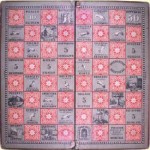 We’ve all played games produced by the Milton Bradley Company: Battleship, Candyland, Jenga, Twister, Yahtzee, and many more. But did you know that the first board game created by Milton Bradley himself back in 1860, was based on the stages of life? It was called “The Checkered Game of Life.” The gameboard was a modification of a checker board (see illustration), and instead of dice, players spun a six-sided top. The game began in Infancy in one corner, and ended in Happy Old Age at the opposite corner. Players accumulated points as they landed on squares, and the first to reach 100 points was the winner. Each black square contained a life event that was either positive (e.g. “Wealth” – 10 points; “Happiness” – 5 points) or negative (e.g. “Crime – go to prison – lose a turn” ; Gambling – go to Ruin”). The journey of life consisted of traipsing one’s way through these open doors to opportunity (“School – go to College”; “College – 5 points”) or laundry chutes to perdition (“Disgrace”; “Suicide”).
We’ve all played games produced by the Milton Bradley Company: Battleship, Candyland, Jenga, Twister, Yahtzee, and many more. But did you know that the first board game created by Milton Bradley himself back in 1860, was based on the stages of life? It was called “The Checkered Game of Life.” The gameboard was a modification of a checker board (see illustration), and instead of dice, players spun a six-sided top. The game began in Infancy in one corner, and ended in Happy Old Age at the opposite corner. Players accumulated points as they landed on squares, and the first to reach 100 points was the winner. Each black square contained a life event that was either positive (e.g. “Wealth” – 10 points; “Happiness” – 5 points) or negative (e.g. “Crime – go to prison – lose a turn” ; Gambling – go to Ruin”). The journey of life consisted of traipsing one’s way through these open doors to opportunity (“School – go to College”; “College – 5 points”) or laundry chutes to perdition (“Disgrace”; “Suicide”).
As Bradley himself warned: “Happy Old Age is surrounded by many difficulties”: land on Idleness, and you’ll be sent to Disgrace, at the very bottom of the board, which means that you have to climb back up all over again. Here’s another word of advice: Don’t enter Politics, if you can possibly avoid it. You’ll go to Congress and earn five points, but you’ll be carried away from Happy Old Age and you’ll woefully increase your chances of landing on Crime and ending up in Prison . . . ” (quoted in Jill Lepore, “The Meaning of Life, The New Yorker, May 21, 2007, p. 41).
To celebrate the 100th anniversary of the first game, the company created The Game of Life that many of us played as kids, and that has been updated for the current generation as The Game of Life: Twists and Turns. In the newest version of the game, each player has a Visa card that they insert into an electronic machine (called a LIFEPod), which stores financial data (yes, it’s now mostly about money), as well as their status in the game.
Before Bradley’s game, there was an earlier game called “The New Game of Human Life” created in London in 1790, where squares represented male individuals at the different stages of life who embodied Protestant virtues and vices (e.g. “The Assiduous Youth” or the “Drunkard” etc.). All of these games were themselves probably based on an ancient board game in India called Jnana Chaupar (the “game of knowledge), where if you landed on a virtue you got to climb a ladder toward the god Vishnu and karmic liberation, whereas if you landed on a vice –or karmic obstacle–you could end up being swallowed by a snake!
For more information about the stages of life in different cultures and traditions, see Thomas Armstrong , The Human Odyssey: Navigating the Twelve Stages of Life
This article was brought to you by Thomas Armstrong, Ph.D. and www.institute4learning.com.
Follow me on Twitter: @Dr_Armstrong



















